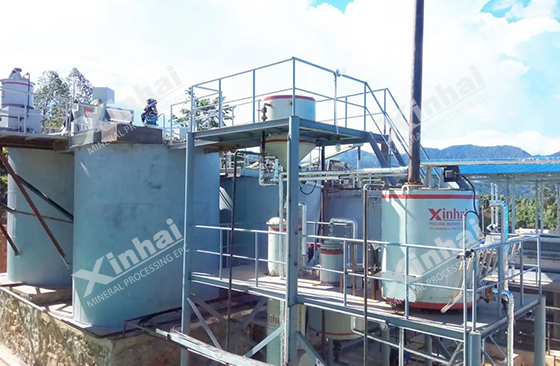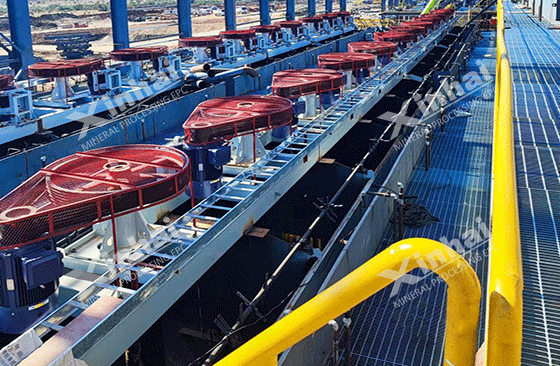As a strategic resource, lithium resources play an important role in the energy revolution and green and low-carbon development. With the increase in application scenarios such as new energy vehicles and energy storage, the demand for lithium resources has increased rapidly. About 35% of the world's lithium resources come from lithium-rich minerals and clays. Lithium-containing minerals in China are mainly spodumene, lithium mica and a small amount of lithium aluminum phosphate. These ores are all found in lithium-rich granite pegmatites. Due to the differences in ore types, the beneficiation process of these minerals are also different.
Use the table of contents below to navigate through the guide:
01Spodumene ore beneficaition process
Spodumene ore is a typical lithium ore with various crystal forms, including columnar, granular or plate-like, and has a monoclinic crystal structure. In the spodumene ore beneficiation process, flotation is the main beneficiation method, in addition to magnetic separation and gravity separation as auxiliary means. Flotation is further divided into positive flotation and reverse flotation.

Spodumene positive flotation utilizes the difference in the surface chemical properties of spodumene and gangue minerals and is carried out in an alkaline medium. First, the ground mineral is added to a strong alkaline medium for high-concentration strong stirring. The high-concentration slurry is treated with sodium hydroxide to remove the slurry under the action of alkalinity, and after multiple washing and desludging, fatty acids or soap collectors are added to directly float spodumene. In this process, the added sodium hydroxide reacts with the silicate gangue minerals in the slurry to form a sodium silicate (water glass) inhibitor. This activates the silica leached from the surface of spodumene, while the gangue minerals generate insoluble compounds due to the activated cations (iron, calcium, copper, etc.) on their surfaces, which are then inhibited, thus achieving the flotation of spodumene.
The combination of "three alkalis and two soaps" is commonly used in the flotation process. "Three alkalis" refers to sodium hydroxide (NaOH), sodium carbonate (Na2CO3) and sodium sulfide (Na2S), which are used as adjusters to optimize the chemical environment of the pulp. "Two soaps" refer to oxidized paraffin soap and cyclopentane acid soap, which are used as collectors with foaming properties to promote the adhesion of spodumene minerals and bubbles. In addition, sodium carbonate and sulfuric acid are used to adjust the pH value. Sodium carbonate is also used to disperse the ore mud and precipitate multivalent harmful metal ions to help remove gangue minerals.

The spodumene reverse flotation method mainly uses lime to create an alkaline environment, adds starch, dextrin, etc. to inhibit the floating of lithium ore, and uses pine oil as a frother. Under alkaline medium (pH 10.5~11.0), dextrin adjusters can effectively inhibit spodumene, and then amine cationic collectors are used to capture silicate gangue minerals such as quartz, feldspar, and mica, leaving the spodumene concentrate in the tank to achieve reverse flotation. Magnetic separation and gravity separation are used as auxiliary methods to remove impurities and further improve the purity of spodumene concentrate.
02Beneficiation process of lithium mica ore
Lepidolite is a monoclinic layered silicate mineral with flaky or scaly aggregates and a rose or light purple color. The beneficiation process of lithium mica ore mainly relies on flotation, which uses the difference in physical and chemical properties of the mineral surface to achieve mineral separation. Since lithium mica has good floatability, positive flotation method is widely used in this process.

In the flotation process, it is first necessary to select a suitable collector to enhance the affinity of lithium mica minerals with bubbles and promote their floating. Commonly used collectors include anionic fatty acids, combined collectors of fatty acids and amines, and cationic amine collectors. In particular, cationic amine collectors, such as octadecylamine, have a good flotation effect on lithium mica in acidic and neutral media. However, lithium mica that has not been activated cannot be effectively captured by oleic acid collectors. Therefore, it is usually necessary to pre-treat lithium mica with an activator such as hydrofluoric acid to improve its floatability and obtain better flotation indicators. After the flotation process, the lithium mica minerals are selected along with the foam and subsequently washed, concentrated and dried to obtain high-grade lithium concentrate.
03Beneficiation process of lithium phosphate aluminum ore
The method of extracting lithium from lithium ore is to first obtain lithium concentrate from minerals rich in lithium and phosphate by flotation, and then perform grinding pretreatment. Concentrated sulfuric acid is then used for leaching to convert lithium and aluminum into soluble sulfates, and fluoride and phosphate are extracted to produce enriched leachate. Acidic impurities are removed by precipitation by adding limestone, lime, monovalent carbonate or hydroxide, and lithium is recovered as a lithium-containing salt product.precipitation, and lithium is recovered as a lithium salt product.

In actual mineral processing plants, mineral processing tests and analyses are required for the types and properties of ores in different deposits. Through mineral processing tests, suitable lithium extraction methods are designed, and lithium mineral processing equipment is customized according to these methods to determine the appropriate mineral beneficiation process. At the same time, the selection and dosage of reagents also need to be reasonably adjusted according to the characteristics of the ore, the requirements of the mineral processing process and the product quality standards. This ensures the smooth progress of the entire mineral beneficiation process and achieves efficient lithium extraction.


 marketing@ytxinhai.com
marketing@ytxinhai.com  0086 13810327080
0086 13810327080 






































































































 CHAT
CHAT MESSAGE
MESSAGE






